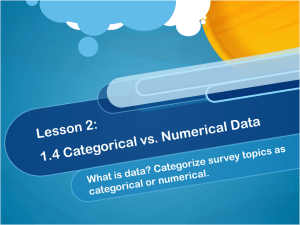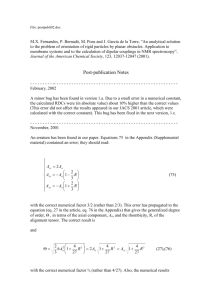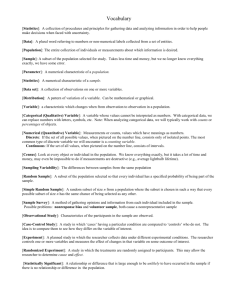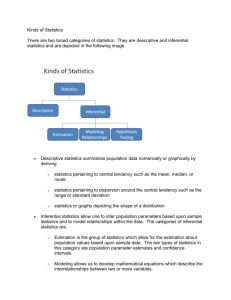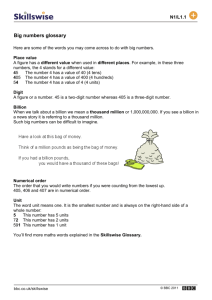6.SP.A.1 Lesson Statistical Questions
advertisement
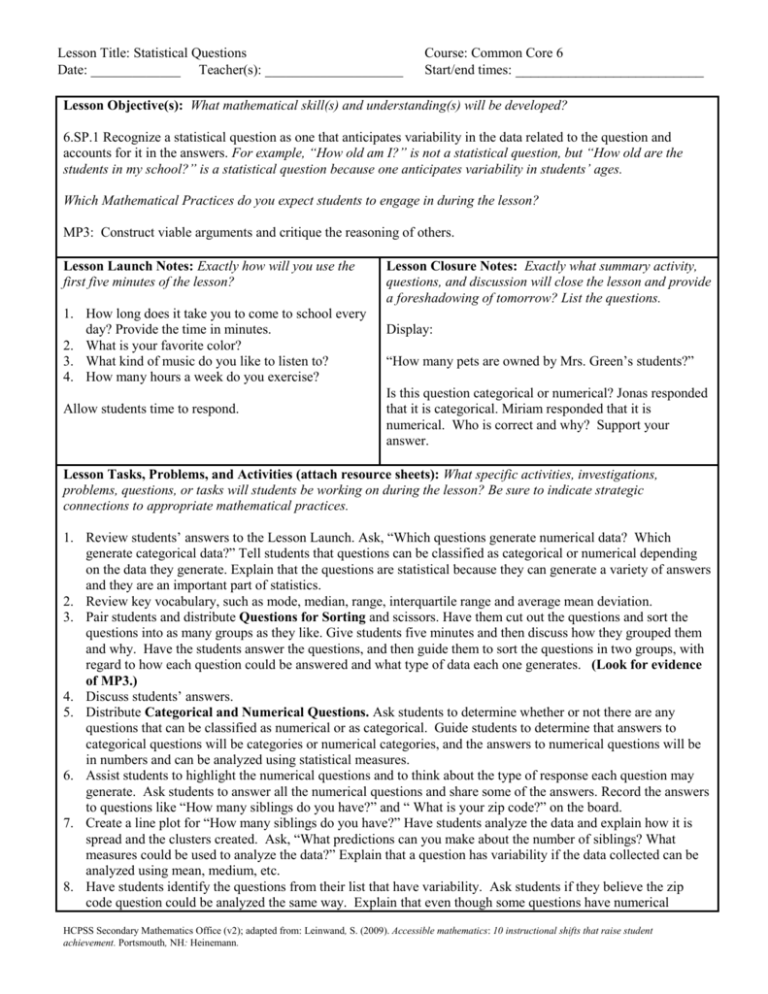
Lesson Title: Statistical Questions Date: _____________ Teacher(s): ____________________ Course: Common Core 6 Start/end times: _________________________ Lesson Objective(s): What mathematical skill(s) and understanding(s) will be developed? 6.SP.1 Recognize a statistical question as one that anticipates variability in the data related to the question and accounts for it in the answers. For example, “How old am I?” is not a statistical question, but “How old are the students in my school?” is a statistical question because one anticipates variability in students’ ages. Which Mathematical Practices do you expect students to engage in during the lesson? MP3: Construct viable arguments and critique the reasoning of others. Lesson Launch Notes: Exactly how will you use the first five minutes of the lesson? 1. How long does it take you to come to school every day? Provide the time in minutes. 2. What is your favorite color? 3. What kind of music do you like to listen to? 4. How many hours a week do you exercise? Allow students time to respond. Lesson Closure Notes: Exactly what summary activity, questions, and discussion will close the lesson and provide a foreshadowing of tomorrow? List the questions. Display: “How many pets are owned by Mrs. Green’s students?” Is this question categorical or numerical? Jonas responded that it is categorical. Miriam responded that it is numerical. Who is correct and why? Support your answer. Lesson Tasks, Problems, and Activities (attach resource sheets): What specific activities, investigations, problems, questions, or tasks will students be working on during the lesson? Be sure to indicate strategic connections to appropriate mathematical practices. 1. Review students’ answers to the Lesson Launch. Ask, “Which questions generate numerical data? Which generate categorical data?” Tell students that questions can be classified as categorical or numerical depending on the data they generate. Explain that the questions are statistical because they can generate a variety of answers and they are an important part of statistics. 2. Review key vocabulary, such as mode, median, range, interquartile range and average mean deviation. 3. Pair students and distribute Questions for Sorting and scissors. Have them cut out the questions and sort the questions into as many groups as they like. Give students five minutes and then discuss how they grouped them and why. Have the students answer the questions, and then guide them to sort the questions in two groups, with regard to how each question could be answered and what type of data each one generates. (Look for evidence of MP3.) 4. Discuss students’ answers. 5. Distribute Categorical and Numerical Questions. Ask students to determine whether or not there are any questions that can be classified as numerical or as categorical. Guide students to determine that answers to categorical questions will be categories or numerical categories, and the answers to numerical questions will be in numbers and can be analyzed using statistical measures. 6. Assist students to highlight the numerical questions and to think about the type of response each question may generate. Ask students to answer all the numerical questions and share some of the answers. Record the answers to questions like “How many siblings do you have?” and “ What is your zip code?” on the board. 7. Create a line plot for “How many siblings do you have?” Have students analyze the data and explain how it is spread and the clusters created. Ask, “What predictions can you make about the number of siblings? What measures could be used to analyze the data?” Explain that a question has variability if the data collected can be analyzed using mean, medium, etc. 8. Have students identify the questions from their list that have variability. Ask students if they believe the zip code question could be analyzed the same way. Explain that even though some questions have numerical HCPSS Secondary Mathematics Office (v2); adapted from: Leinwand, S. (2009). Accessible mathematics: 10 instructional shifts that raise student achievement. Portsmouth, NH: Heinemann. Lesson Title: Statistical Questions Course: Common Core 6 Date: _____________ Teacher(s): ____________________ Start/end times: _________________________ answers, they can be classified as categorical because they do not have variability and cannot be statistically analyzed using mean, median, etc. Allow students to go back to Categorical and Numerical Questions and identify whether or not they classified any questions as numerical when they should have been classified as categorical. 9. Tell students that the questions we looked at are statistical questions because they generate a variety of answers. The questions that generate numerical data have variability because the data can be statistically analyzed. Ask students to find the difference between the following questions: “What is my height?” and “What is the height of all six graders at our school?” Even though both questions are numerical, which one is non-statistical? Have students explain. Provide students with examples of non-statistical questions and ask them to change them to statistical. Ask students to define non-statistical questions. (Look for evidence of MP3.) 10. Present the closure question to the class and discuss the solution. Evidence of Success: What exactly do I expect students to be able to do by the end of the lesson, and how will I measure student mastery? That is, deliberate consideration of what performances will convince you (and any outside observer) that your students have developed a deepened (and conceptual) understanding. Students should be able to distinguish the difference between categorical and numerical questions and which statistical questions have variability. Students should be able to explain their reasoning behind the classifications. The teacher will measure student understanding through student participation in discussions, and students’ ability to categorize the questions. The homework will also provide evidence of students being able to recognize the types of questions. Notes and Nuances: Vocabulary, connections, common mistakes, typical misconceptions, etc. Vocabulary: variability, numerical, categorical, statistical Misconceptions: Classifying questions with numerical answers as numerical questions when they are actually categorical. (Example: zip code) Resources: What materials or resources are essential for students to successfully complete the lesson tasks or activities? Homework: Exactly what follow-up homework tasks, problems, and/or exercises will be assigned upon the completion of the lesson? Questions for Sorting Scissors, one per pair Categorical and Numerical Questions Numerical and Non-numerical Questions Categorical and Numerical Questions Homework Distribute Categorical and Numerical Questions Homework. Students will identify each question as numerical or categorical, they will create a numerical and categorical question, and they will create a statistical and a nonstatistical question. Lesson Reflections: How do you know that you were effective? What questions, connected to the lesson standards/objectives and evidence of success, will you use to reflect on the effectiveness of this lesson? Are the students able to identify examples of categorical and numerical questions/data? Are the students able to determine the difference between a statistical and a non-statistical question? Are the students able to determine numerical questions that generate variability? HCPSS Secondary Mathematics Office (v2); adapted from: Leinwand, S. (2009). Accessible mathematics: 10 instructional shifts that raise student achievement. Portsmouth, NH: Heinemann.
